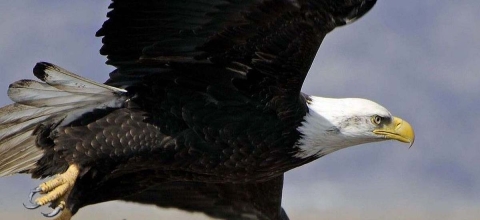Endangered Species Act Milestones: 2000s
The decade that knew the threat of Y2K and the terror that was 9/11, also realized new challenges in the conservation of endangered and threatened species as a result of a changing climate change climate change
Climate change includes both global warming driven by human-induced emissions of greenhouse gases and the resulting large-scale shifts in weather patterns. Though there have been previous periods of climatic change, since the mid-20th century humans have had an unprecedented impact on Earth's climate system and caused change on a global scale.
Learn more about climate change and other stressors including white nose syndrome and chytrid fungus—two emerging infectious diseases that have continued to devastate bat and amphibian populations on a large scale. Not all was woeful in the 2000s, however. The American bald eagle – the very symbol of our nation's strength – was recovered and removed from the list of endangered and threatened species. And through continued work with the community, business, and governments, the future grew brighter for a number imperiled plants and animals on privately owned land. A suite of new tools and incentives, including a Recovery Crediting System, the first Candidate Conservation Agreement, and establishment of the first conservation bank, all helped to promote and enhance the recovery of listed species on subject lands.
2000
The Oregon Department of Fish and Wildlife develops the first Candidate Conservation Agreement with Assurances to benefit the Columbian sharp-tailed grouse.
Wyoming Farm Bureau Federation v. Babbit
2001
The Aleutian Canada goose is delisted following recovery.
2002
The Robbins' cinquefoil, a diminutive New England wildflower, is delisted following recovery.
2003
Conservation banking guidance addresses the establishment, use, and operation of conservation banks to offset adverse impacts to listed species.
The Columbian white-tailed deer is delisted following recovery.
Hoover's wooly-star is delisted following recovery.
2004
The California condor reproduces in the wild for the first time in 17 years.
Camp Shelby, U.S. Army installation in Mississippi, develops the first candidate conservation agreement for the Camp Shelby burrowing crayfish.
Congress enacts the ESA Amendment of 2004.
2005
Biologists reintroduce several thousand mussels, including the endangered purple bean mussel, into Virginia's Clinch River. A toxic spill in 1998 killed most aquatic life in that stretch of the river.
The Eggert's sunflower is delisted following recovery.
2006
White-nose syndrome is first discovered in a single cave near Albany, New York. The fungal disease has since spread to 19 states and four Canadian provinces, and killed more than 5.7 million bats, including federally endangered gray bats and Indiana bats.
2007
The Warm Springs Zaitzevian riffle beetle, an insect in Montana, is removed from the list of candidate species due to the conservation practices implemented as part of a 1994 candidate conservation agreement.
After nearly disappearing from most of the United States decades earlier, the bald eagle successfully recovers and is removed from ESA protection.
The death of Ozark hellbenders in the St. Louis Zoo's captive population from chytrid fungus (Batrachochytrium dendrobatidis, or Bd) prompts the testing of Missouri's wild hellbenders, a then candidate species for ESA protection. Results show chytrid fungus is present in all remaining populations in Missouri.
The first wild California condor chicks hatch in Arizona.
The U.S. Fish and Wildlife Service (Service) finalizes the Recovery Crediting System, a tool available to federal agencies to promote and enhance the recovery of listed species on non- federal lands.
2008
The Service approves the Coachella Valley Habitat Conservation Plan on 1.1 million acres in California for 27 species including the threatened Coachella Valley fringe-toed lizard.
The first combination candidate conservation agreement and candidate conservation agreement with assurances brings together the Service, the Bureau of Land Management, and a private group to conserve the lesser prairie-chicken and the dunes sagebrush lizard.
The polar bear is listed as threatened due to ice flows melting in the Arctic. This is the first species the Service lists under the ESA due to the impacts of climate change.
2009
Due to a combination of the banning of DDT and ESA protection, more than 650,000 brown pelicans could be found across Florida and the Gulf and Pacific Coasts, as well as in the Caribbean and Latin America, and so it was removed from federal protection.




